home | internet service | web design | business directory | bulletin board | advertise | events calendar | contact | weather | cams

 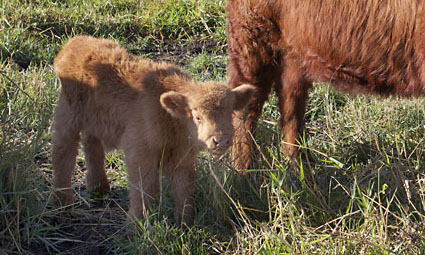 Glenda, a brindle Highlander (in top photo), and her calf, Buddy, who is two weeks old in this photograph. Hover saw him born. Glenda, a brindle Highlander (in top photo), and her calf, Buddy, who is two weeks old in this photograph. Hover saw him born. Small farming in the Methow PART FIVE OF A SERIES Jennifer Hover is the high-energy farmer behind the Hover Highland Cattle Company. She is raising and selling grass-fed specialty beef from a growing herd of the shaggy, double-coated cattle, which have some of the oldest known registered bloodlines. There is archeological evidence that the Highland breed has been grazing the Scottish Highlands since the 6th century, according to the American Highland Cattle Association. They have been grazing in the Methow Valley at least since 2005 on pasture at the old Sunny M Ranch at the intersection of Wolf Creek and Twin Lakes roads, and on pasture behind Hover’s home. The Highland breed is very tolerant of cold, wet conditions, but needs shade in warm weather. And while their double-hair coats and stocky build make them look large, Hover said they have fine bones and are considered medium-sized cattle. 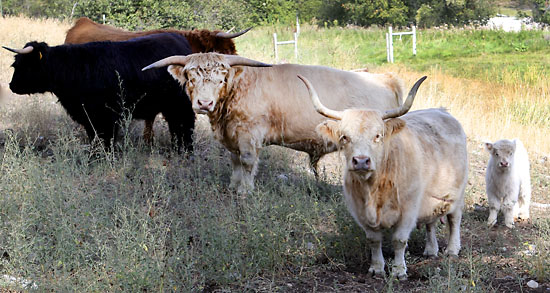 Kirby, a white Highlander, and her calf, Hannah, who is about six weeks old in this photograph, stare at the camera. Standing with them are, from left, Caitlin, Dimple and Jamie the bull. Highland cattle grow until they are six years old. The females tend to have upswept horns and the males more forward pointing ones, according to the Highland Cattle Association website. Kirby, a white Highlander, and her calf, Hannah, who is about six weeks old in this photograph, stare at the camera. Standing with them are, from left, Caitlin, Dimple and Jamie the bull. Highland cattle grow until they are six years old. The females tend to have upswept horns and the males more forward pointing ones, according to the Highland Cattle Association website.Her original plan was to build a fold (the proper term for a herd of Highlands) of about 30 animals. However, a wintertime head-on car accident nearly two years ago left her with a permanent, partial disability. Her back won’t tolerate lifting the amount of hay a large number of animals would require, she says. For the same reason, she’s also given up the idea of showing her cattle and training them to be led in Winthrop’s annual ’49er Days parade. Her revised plan is to keep Jamie, her bull, and about seven cow-calf pairs plus another seven one-year-old animals to butcher each year. All the cattle are registered. The cows are two years old before she breeds them for the first time. At the moment she has four pregnant cows, three of them purchased in Montana. Hover says the three “Montana girls”—Dimple, Caitlin and Gilliam—are named for Scottish whisky. Her “fully mature, rated show cow,” Seline, also is expecting, probably in November, but as sometimes is the case on farms, Seline’s due date is not known for certain. 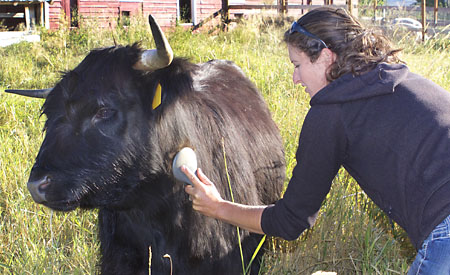 Dimple, one of the pregnant “Montana girls,” loves getting brushed so much that Hover calls her “a brush whore.” The cow does a fast walk toward her owner whenever she sees brush in hand. Dimple, one of the pregnant “Montana girls,” loves getting brushed so much that Hover calls her “a brush whore.” The cow does a fast walk toward her owner whenever she sees brush in hand. Hover first came to the Methow Valley when she was selling building supplies. She has a background in “old school marketing, advertising and promotion. I loved the valley but there was nothing for me to do here,” she says. Then she married Andy Hover— the manager of North Valley Lumber on Horizon Flats, who grew up farming—and put her business savvy to work. The couple has one son, Saxton, who is seven years old and his mother’s helper. In addition to cattle, this year Hover is raising more than 100 chickens, which are fed three times a day, and two turkeys. She has three horses, a dog and assorted cats and keeps a large vegetable garden plus pear, apple and plum trees that help feed her family. The hardworking, stay-at-home mom told Grist it is her in-laws land, hay and help that have made her farm plan possible. Andy is the son of Bud and Tonya Hover and brother of Wes Hover, who raises a grass/alfalfa hay mix on about 300 acres of land. Former Okanogan County Commissioner Bud Hover is now the director of the Washington State Department of Agriculture and works out of Olympia, although he occasionally helps Wes. Andy’s family lives on his maternal grandparents’ former place. Jennifer Hover, a “late-30s” Entiat Valley native, says she was raised on 160 acres of land. “I’ve had horses my whole life,” she says. Her family also kept a small flock of chickens. She is building a much larger poultry business. 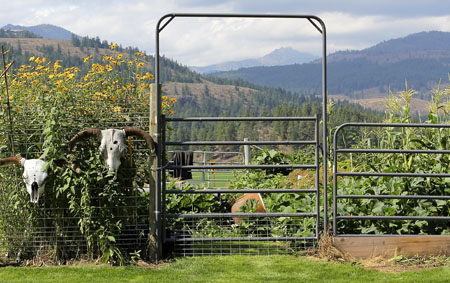 Looking toward Mt. Gardner through the gate of Jennifer Hover’s nutrient rich vegetable garden. Looking toward Mt. Gardner through the gate of Jennifer Hover’s nutrient rich vegetable garden.“I think the valley can handle 600 laying hens,” she says, based on market research at local restaurants and elsewhere. “The plan is that over the next three years I’ll take the layers to 300 [birds].” The hens will be Jersey Giants, a heritage meat bird breed that lays jumbo eggs, and some Australorps. Her dad is the person responsible for her interest in Highland cattle. He was a landscape contractor who had a series of four heart attacks that started while Jennifer was still living at home. “We changed our eating habits,” she says. Their new diet included the leaner, lower cholesterol beef from Scottish Highland cattle. “Once you go Highland, you never go back,” she says of eating the beef. A few years back her dad came across a man who was moving and needed to sell a Highland. That animal is long since consumed but helped inspire the creation of the Hover Highland Cattle Co. Hover’s beef is sold out and she won’t be butchering again until next year. She sells down to a quarter animal. The price depends on the finish—grass or grain—and the market at the time of sale. She worked with a chef at Washington State University to get top flavor, she says. Important factors include how the animals are slaughtered and butchered, she adds. Hover hires a slaughterer from Tonasket. And after checking out every shop in Okanogan County, she settled on a butcher shop in Brewster to cut and package the meat. 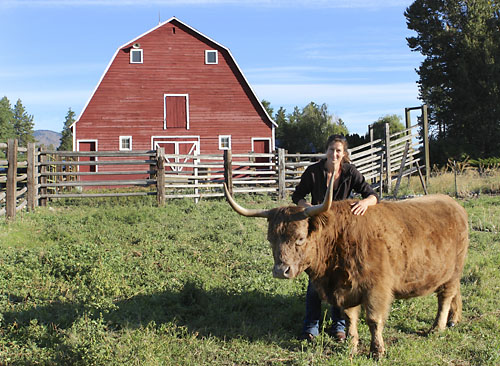 Jennifer Hover brushes Frosty, the first Highland cow raised on her property. Born when it was minus 14 degrees Frosty had a layer of frost between her skin and hair thus her name. The Hovers moved her into their kitchen. Frosty will give birth any day. The barn is part of the old Sunny M Ranch in lower Wolf Creek. Jennifer Hover brushes Frosty, the first Highland cow raised on her property. Born when it was minus 14 degrees Frosty had a layer of frost between her skin and hair thus her name. The Hovers moved her into their kitchen. Frosty will give birth any day. The barn is part of the old Sunny M Ranch in lower Wolf Creek.With experience and “a full business plan” in hand, Hover signed up for the Sustainable Small Farm Course taught in Twisp earlier this year. “The class helped structure a lot of my thoughts that were still random,” she says. For example, she says her original purpose was “to contribute” to sustainable farming practices. “My program allows me to build up old farm ground,” she explains. Where once the old ranch pasture was mustard and knapweed, “the Sunny M is now green and the soil is coming back,” she says. The animals’ cloven hooves “aerate the soil.” And because the cattle “kind of gum the grass” they can’t graze it down to the roots and it regrows quickly. Hover also rotates the cattle across three different pasture sections where they lay down their manure. At home her chickens wander the farmyard and run free on the grass. “They get rid of most of your weeds, she says, “first the dandelions and then the clover.” Her vegetable garden is dressed with compost that is one-third shavings and two-thirds chicken manure. And that compost is helping grow “lots of squash,” which the chickens will eat all winter, plus many other vegetables. Hover is contributing to the resurgence of sustainable small farming practices. The Highland cattle are at the recovering end of an endangered species list, she says. And the Jersey Giant chickens are disappearing. “We are taking species that are disappearing from our farm world and bringing them back,” she says. In addition, she says she has the satisfaction of feeding her family “amazing food” and supporting her “own physical well being.” 9/6/2013 Comments
|